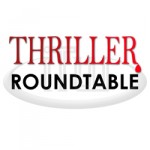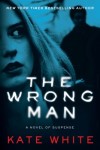 This week we’re joined by ITW Members Kate White, Eric Red, Bob Doerr and A. J. Kerns, discussing what steps should writers take when they disagree with the publisher’s choice of a cover?
This week we’re joined by ITW Members Kate White, Eric Red, Bob Doerr and A. J. Kerns, discussing what steps should writers take when they disagree with the publisher’s choice of a cover?
~~~~~
 Kate White, the former editor-in-chief of Cosmopolitan magazine, is the New York Times bestselling author of six Bailey Weggins mysteries and four stand-alone suspense novels, including Eyes on You, and the upcoming The Wrong Man (June 16). She is also the editor of The Mystery Writers of America Cookbook.
Kate White, the former editor-in-chief of Cosmopolitan magazine, is the New York Times bestselling author of six Bailey Weggins mysteries and four stand-alone suspense novels, including Eyes on You, and the upcoming The Wrong Man (June 16). She is also the editor of The Mystery Writers of America Cookbook.
 Eric Red is a Los Angeles based novelist, screenwriter and film director. His first novel, Don’t Stand So Close, is available in hardcover and trade paperback from SST Publications. His second and third novels, the werewolf western The Guns Of Santa Sangre and the sci-fi monster novel It Waits Below, are available from Samhain Publishing. Recent published short stories have been in Weird Tales Magazine, Cemetery Dance Magazine, Shroud Magazine, and the Dark Delicacies III: Haunted anthology. He created and wrote the comic series and graphic novel Containment for IDW Publishing and the comic series Wild Work for Antarctic Press. His films include The Hitcher, Near Dark, Cohen and Tate, Body Parts, Bad Moon and 100 Feet.
Eric Red is a Los Angeles based novelist, screenwriter and film director. His first novel, Don’t Stand So Close, is available in hardcover and trade paperback from SST Publications. His second and third novels, the werewolf western The Guns Of Santa Sangre and the sci-fi monster novel It Waits Below, are available from Samhain Publishing. Recent published short stories have been in Weird Tales Magazine, Cemetery Dance Magazine, Shroud Magazine, and the Dark Delicacies III: Haunted anthology. He created and wrote the comic series and graphic novel Containment for IDW Publishing and the comic series Wild Work for Antarctic Press. His films include The Hitcher, Near Dark, Cohen and Tate, Body Parts, Bad Moon and 100 Feet.
 Arthur Kerns is a retired FBI supervisory special agent and past president of the Arizona chapter of the Association of Former Intelligence Officers (AFIO). His award-winning short fiction has appeared in numerous anthologies. He is a book reviewer for the Washington Independent Review of Books. In March 2013 Diversion Books, Inc. published his espionage thriller, The Riviera Contract and in May 2014 the sequel, The African Contract.
Arthur Kerns is a retired FBI supervisory special agent and past president of the Arizona chapter of the Association of Former Intelligence Officers (AFIO). His award-winning short fiction has appeared in numerous anthologies. He is a book reviewer for the Washington Independent Review of Books. In March 2013 Diversion Books, Inc. published his espionage thriller, The Riviera Contract and in May 2014 the sequel, The African Contract.
 Award winning author Bob Doerr grew up in a military family, graduated from the Air Force Academy, and had a career of his own in the Air Force. Bob specialized in criminal investigations and counterintelligence gaining significant insight to the worlds of crime, espionage and terrorism. A full time author with eight published books, Bob was selected by the Military Writers Society of America as its Author of the Year for 2013. The Eric Hoffer Awards awarded No One Else to Kill its 2013 first runner up to the grand prize for commercial fiction. Loose Ends Kill won the 2011 Silver medal for Fiction/mystery by the Military Writers Society of America. In May 2014, he released an international thriller titled The Attack. Bob lives in Garden Ridge, Texas, with Leigh, his wife of 42 years, and Cinco, their ornery cat.
Award winning author Bob Doerr grew up in a military family, graduated from the Air Force Academy, and had a career of his own in the Air Force. Bob specialized in criminal investigations and counterintelligence gaining significant insight to the worlds of crime, espionage and terrorism. A full time author with eight published books, Bob was selected by the Military Writers Society of America as its Author of the Year for 2013. The Eric Hoffer Awards awarded No One Else to Kill its 2013 first runner up to the grand prize for commercial fiction. Loose Ends Kill won the 2011 Silver medal for Fiction/mystery by the Military Writers Society of America. In May 2014, he released an international thriller titled The Attack. Bob lives in Garden Ridge, Texas, with Leigh, his wife of 42 years, and Cinco, their ornery cat.

When a disagreement arises with the choice of a cover, first step, be as “Diplomatic” as possible. Now that’s easy for me to say because I’ve been lucky having Diversion Books, Inc. as my publisher. For my two Hayden Stone espionage/thrillers my publisher came up with a cover they thought best advertised my novels. I had some suggestions on color and design and we worked out a very satisfactory compromise. I still like the covers and have gotten good feedback from my readers.
That said, I have fellow writers who have had no say in the design of their books. The publisher presented a cover for their book with no input from them. Period. No amount of yelling, pleading, or outright bribery worked to get it changed or altered. The cover stayed even though it was cheesy, dull, and had nothing to do with the theme or story line. The author has to live with it.
For those who self-publish the choice is theirs and the author soon learns it’s not an easy task to come up with something that catches the eye and makes the potential buyer pick that book off the shelf.
One tip for authors. When signing that book contract, slip in the option that you have some say, or at least have a one-time opportunity to tweak the design and color.
I believe that when you first sign a deal with a publisher, you should indicate that you want to be able to weigh in on the cover so you’re on record with it and they’ve agreed. After you’ve submitted a final manuscript, discuss any thoughts you have about a cover with your editor so that she can pass those along to the art department before they even start. It’s always better to give early direction rather than try to correct a problem. I’ve always had a say in my covers and really love working with my publisher on them, but there have been a few times when I did have to ask them to go back to the drawing board, so to speak. As Arthur says you have to be diplomatic. Start with the positive and avoid negative words, then offer some clear direction, giving your reasons. I’ve said things like, “I love the mood of the cover, but it would be great if the woman had a hipper hairstyle because she’s in a very hip business.”
We’ve all heard the saying you shouldn’t judge a book by its cover, but there’s no doubt a good cover can help sell a book. To help preclude any disagreements over the book cover, I think it’s very important for an author to understand his or her role in cover design right from the day the contract is signed. I’ve been very fortunate with my publisher, TotalRecall Publications. TRP has the final decision on the cover, which makes sense since they are doing the work and covering the cost. However, before designing the cover they bounce ideas off me. When they have what they consider the first draft of the book cover, front and back, they email me a copy and ask for my thoughts. I don’t make final decisions, but it’s a very healthy relationship, because they do often act on my recommendations. I believe the key, no matter how much of an input you can make, is to make your suggestions to your publisher as logical and non-confrontational as possible.
I have had some personally painful experience in this regard. The publisher’s first draft for my first novel, MAXIMUM IMPACT, was excellent. The book is about the crash of a new generation of commercial airliner and the coverup of the cause. The initial cover idea was the aftermath of the crash as viewed from above. Eventually the publisher nixed that idea out of concern that a depiction of a plane crash would put off booksellers in every airport in the world. So the image was changed — to a flying 747, which doesn’t look anything at all like the aircraft in the story. I complained bitterly about it but was told it was too late the fix it.
When the paperback came out a year later, the cover used the aerial view of a crash scene — the original idea — and the book appeared in virtually every airport bookstore in the country.
Flash forward to my second novel, HANDYMAN. The initial cover drawing was fabulous. But it was nixed by the publisher again because it made the book seem like a horror story. Jeez, it was about a serial killer. Horror story works for me. The eventual cover conveyed absolutely zero idea of what the book was about.
The cover for my current book, THE SOMEDAY FILE, is perfect — because I had it designed to my specifications. And when I put up my first two books as my backlist, they will have new covers in line with what I wanted for them in the first place.
I found the entire experience exhausting and frustrating.
I’ve always been very hands-on about the design of the covers for my novels with my publishers, because my movie background trained me in the marketing value of a good film poster in selling a film. Book covers and movie posters are similar in that the best ones involve a simple, powerful iconic image that grabs the reader or viewer and pulls them in. It’s important for the author to have input on that.
My first novel DON’T STAND SO CLOSE I photographed the cover image myself in a studio and publisher did the typeset. The book is about a high school student who is drawn into a dangerous sexual affair with his beautiful teacher, so I did a shot of an apple with a knife in it, dripping blood. For the second edition, I reshot the image with a busty model holding the apple and knife by her cleavage because I felt the erotic aspects needed to be enhanced on the cover.
For the last three of my four books, I’ve worked exclusively with a brilliant illustrator named John Gallagher on the cover design. Long before publication I send John loads of graphics and we discuss and discover together what we feel is the right clean iconic image that sums the book up. Don D’Auria, the editor at my publisher Samhain, is of course involved with these creative conversations, providing important input from his marketing viewpoint. In each of my Samhain books, THE GUNS OF SANTA SANGRE, IT WAITS BELOW and WHITE KNUCKLE, the three of us have ended up in total agreement about the right cover image, which John the illustrator then executes with tremendous detail and style. Samhain does the typeset and final layout.
Each book is different and so are the covers. THE GUNS OF SANTA SANGRE is a werewolf western, so the cover is a dynamic image of a gunslinger facing off with a wolf man rendered in a worn pulp novel graphic style with leathery chiaroscuro of browns and reds. IT WAITS BELOW is an undersea sci-fi monster novel, so the sea monster was front and center graphically, and the color palate ocean blue. My current novel, WHITE KNUCKLE, is about an FBI agent hunting a serial killer long hauler truck driver, so the cover is a big rig coming at the reader that looks equal parts machine and animal or monster. All of the covers have received a lot of praise and we’ve sold a lot of books.
Again, the process of designing and creating a good book cover is very much like a movie poster, in that you want to grab people so they buy the book as they would buy a ticket. I’ve always been very proactive in the book cover process, and have been satisfied every time.